A Russian Soyuz-2.1b launch vehicle, coupled with a Fregat upper stage and carrying a Meteor-M meteorological satellite and additional secondary payload smallsats, was successfully launched on July 8th at 15:58 GMT from the Baikonur space center in Kazakhstan, according to Roscosmos.
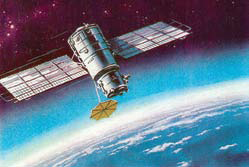
Artistic rendition of Russia’s Meteor M2 satellite.
The primary payload is the Meteor M2, one of four Russian meteorological satellites the country hopes to orbit no later than 2015. In a sun synchronous orbit, at an altitude of 835 kilometers, this satellite has a life expectancy of five years.
The 2,778-kilogram Meteor-M No. 2-1 satellite is designed to track global weather, the ozone layer as well as the ocean surface temperature and ice conditions to facilitate shipping in polar regions and to monitor radiation environment in the near-Earth space. The payload package onboard Meteor-M No. 2 includes:
• Multi-channel imaging scanner, MSU-MR
• Multi-channel imaging complex, KMSS
• Ultra-high frequency temperature and humidity radiometer, MTVZA-GYa
• Infrared Fourier spectrometer, IKFS-2
• Radar complex, BRLK Severyanin
• Heliophysics instrument complex, GGAK-M
• Radio relay complex, BRK SSPD
The satellite was designed to operate in orbit for five years. It will become the second spacecraft in the Meteor-3M network, complementing the Meteor-M No. 1 satellite, which was launched on Sept. 17, 2009. In addition, the Russian space program funds the development of the two similar Meteor-M No. 2-1 and 2-2 satellites, as well as the Meteor-M No. 3 satellite, which is custom-designed to carry a phased-array radar for high resolution observations of the ocean surface.
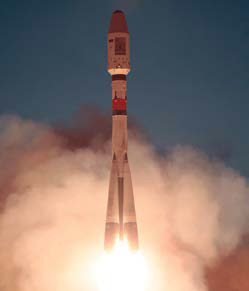
A Russian Meteor-M No. 2 primary satellite and secondary payloadslift off on July 8, 2014, aboard a Soyuz-2.1b launch vehicle. Photo is courtesy of Roscosmos.
All spacecraft in the series were developed by the Moscow-based VNIIEM corporation based on its Resurs-UKP platform. At the start of 2014, the launch of the follow-on Meteor-M No. 2-1 satellite was scheduled for 2015.
The secondary payloads, in alphabetical order, are:
AISSat-2
The AISSat-2 satellite, funded by the Norwegian Space Centre with support from the Norwegian Defence Research Establishment, is identical to AISSat-1 and incorporates all the improvements made to AISSat-1 following its launch.
Given the great success of AISSat-1, the development of AISSat-2 implies that SFL’s nanosatellite solution has become ideal for operational monitoring and tracking of ships in Norwegian territorial waters.
While AISSat-1 was intended to be a demonstration mission, the impact of its quick success and reliable performance was an almost immediate paradigm shift. Norway quickly promoted AISSat-1 to operational status and the nanosatellite approach was adopted for Norway’s operational AIS constellation.
AISSat-2 will increase coverage, shorten revisit times, and provide natural redundancy for space-based AIS observation under direct control by Norway.
The Soyuz-12.1B rocket carried the satellite to orbit after lifting off at 15:58 UTC. After separating the primary payload, the Meteor-M No. 2 satellite, the Fregat upper stage maneuvered to a lower 643km altitude orbit and dropped off AISSat-2 along with other secondary payloads.
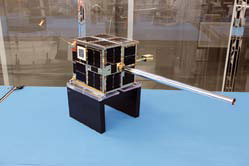
At approximately 19:26 UTC, the first pass over Norway’s ground stations in Svalbard resulted in successful contact with AISSat-2, confirming that all systems were healthy.
Early data collection from the AIS receiver was also initiated and messages from ships were successfully received. Due to the past success of AISSat-1, commissioning of the AISSat-2 satellite is expected to proceed at an accelerated rate.
Alex Beattie, SFL’s project manager for AISSat-2, was in Oslo for first contact with AISSat-2. Working together with the operations team at SFL in Toronto, the satellite is poised to become one of the most quickly commissioned satellites developed by SFL in recent history.
AISSat-2 is Norway’s second satellite in orbit and represents a great accomplishment for the country and its people. The satellite will work in tandem with AISSat-1 to provide greater coverage over Norwegian territorial waters. In fact, shortly after AISSat-2’s first pass, AISSat-1 was contacted as part of its routine operations. “Some new company for AISSat-1 in orbit!” said Alex Beattie.
The University of Toronto Institute for Aerospace Studies’ The Space Flight Laboratory (SFL) mission is to lower the entry barrier to space for companies, research institutions, government, and end users in order to enable more productive use of space for the next generation. SFL believes in offering the lowest cost possible to achieve objectives in space while adhering to approaches known to result in high quality and high reliability.

Additional, Recent UTIAS SFL Successes
SFL’s goal is to apply the microspace philosophy to a wide range of mission objectives, thereby expanding the possible applications that are within reach of organizations with limited budgets. Simply put, SFL’s business is to challenge the current state-of-the-art in space technology performance while achieving remarkably low cost without sacrificing quality or introducing risk.
In an age where significant advances have been made in data processing and information technology, SFL strives to leverage the latest advances in commercial technologies to provide performance advantage in space for tomorrow’s space-based data users.
In a little over two weeks, the Space Flight Laboratory has launched five satellites. Two satellites are Canadian BRIght Target Explorer (BRITE) satellites for studying luminous stars from orbit (launched on June 19, 2014, on a Dnepr rocket from Yasny, Russia).

Two additional satellites are the CanX-4 and CanX-5 formation flying satellites (launched on June 30, 2014, on PSLV-C23 from Sriharikota, India). Then came the aforementioned AISSat-2 onboard the Soyuz-2.1B. With the exception of one of the two BRITE satellites, all satellites have been contacted and confirmed healthy—the BRITE-Montreal satellite is believed not to have separated from its Dnepr launch vehicle.
The four satellites have also been making swift progress in commissioning. After only eight days on orbit, BRITE-Toronto entered fine pointing with accuracy and stability better than one arcminute (12 arcsec RMS), and, since then, has been managing regular observations of Centaurus and Cygnus.
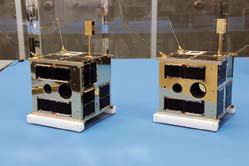
The BRight Target Explorer satellites. Photo is courtesy of SFL.
BRITE-Toronto joins three other successful BRITE satellites already operating in orbit, all based on SFL satellite technology. Also, in just over a week’s time, the CanX-4 and CanX-5 satellites have been largely commissioned, including their on-board propulsion systems, and will soon execute a drift recovery maneuver as a prelude to their tandem formation flying demonstrations. AISSat-2 was contacted during its first pass over Svalbard, within hours of launch. During its first pass, which only lasted about 10 minutes, several on-board systems were commissioned quickly, thanks to prior experience with AISSat-1. Also during its first pass, AISSat-2 detected many ships, confirming the operation of its main mission payload.
“Today is a great day for SFL,” said Dr. Robert E. Zee, Director of SFL, “Not only have we demonstrated the versatility of SFL’s small satellite technology, which offers high performance in a miniature package at ultra-low cost, but we have demonstrated the robustness and grittiness of SFL’s XPOD dispenser, which continues to be a reliable workhorse for nanosatellite separations from many different launch vehicles.”
SFL’s XPOD dispenser has successfully ejected 22 satellites to date from the Cosmos-3M, PSLV, Dnepr, and Soyuz 2-1B rockets.
“Although we are a bit saddened about the lack of separation of BRITE-Montreal, we have seen no evidence to suggest that there was anything amiss with the XPOD responsible for its ejection. We continue to ask the launch agency, Kosmotras, for a detailed telemetry report to help us to understand what happened,” said Zee. “There is a small chance that the XPOD will still deploy BRITE-Montreal, as the cord that holds the clamping mechanism together may degrade in the space environment over time. SFL will continue to send commands when the Dnepr upper stage is overhead, in case the XPOD deploys BRITE-Montreal. We never give up hope.”
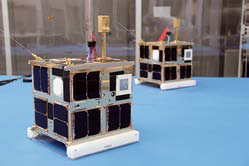
CanX-4 + CanX-5 cubesats. Photo courtesy of SFL.
With four new satellites working just fine in orbit, SFL now boasts 11 operational satellites that they have either developed in house or played a major role in developing. With more satellites to be launched and under construction, SFL remains Canada’s most prolific satellite builder and exporter of complete satellite missions.
For further information regarding UTIAS SFL, please visit http://utias-sfl.net/
DX-1
DX-1, from Dauria Aerospace, will track navigation on waterways throughout North America, Northern Europe, as well as Russia. This smallsat carries an AIS payload on a proprietary platform that was completely designed and built by the company and takes advantage of the ongoing growth in the remote sensing industry.
DX-1 joins the company’s Perseus constellation and is the first and only moderate resolution Earth Observation (EO) satellite constellation that delivers monitoring services. A proprietary, low-cost approach offers imagery at an affordable price, making the data widely accessible.
AMSAT UK (Radio Amateur Satellites) is requesting assistance from all radio amateurs who are interested in receiving signals from this spacecraft. The organization invites all to participate in the “catching” of the satellite immediately after the launch.
Based on the parameters of the DX-1’s orbit, the satellite’s separation from the upper stage occurred over Eastern Europe and the spacecraft returned above Russia after only a few hours from its “travels” over the Far East. The AMSAT UK MCC in Moscow held the first session the day after the launch.
Beacon satellite broadcasts in amateur radio frequency—everyone was be able to “hear” DX-1 before the organization itself. AMSAT UK needed to clarify and confirm the satellite’s orbit performance. Those who assist as “lucky hunters” from around the world will be receiving souvenirs.

The parameters of the radio beacon mode:
• Carrier frequency: 438.225 MHz [it is understood there is a 145 MHz command uplink]
• The protocol used: AX.25
• Call Sign source: DSC001
• Call Sign Receiver: Dauria
• Size TMI frame within AX.25 packet: 55 bytes
• Speed: 9600 bit / s
• Modulation GFSK
Source: http://habrahabr.ru/company/dauria/blog/228669/
The Google English Version is located at http://tinyurl.com/pdueyt2
The satellite will also be using the following frequencies:
• 162.0125-162.0375 MHz Uplink – AIS ship tracking receiver
• 2269.5-2270.5 MHz Downlink – Data
AMSAT-UK is an information service that offers a first class magazine in OSCAR News (free to members at least every three months), and provides technical data and advice on all aspects of amateur satellite communications. Orbital data and general assistance to all radio amateurs wishing to enter this specialized part of the hobby is still available at minimal cost.
For further information regarding AMSAT UK, please visit http://amsat-uk.org/
Relek (MKA-PN 2)
The MKA-PN 2 satellite, also known as Relek for its scientific payload, is a smallsat dedicated to the study of energetic particles in the near-Earth space environment, including the Van Allen Belts. The last Russian satellite to study charged particles flew in 2001. Scientists wanted the continued flow of data regarding particle distribution around Earth for geophysical research and space weather monitoring. Additionally, part of the Relek mission is dedicated to the participation of young scientists to allow them to gather valuable experience in the operation of a scientific satellite mission.
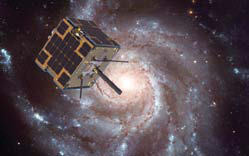
Artistic rendition of the DX-1 in space. Image is courtesy of Dauria Aerospace.
The Relek satellite weighs under 250kg. and is based on the Karat satellite bus manufactured by NPO Lavochkin. The spacecraft features three deployable, fixed solar panels that deliver a peak power of 100W for distribution to the satellite’s subsystems and batteries. Attitude determination is accomplished with star trackers, a magnetometer and sun sensors, as well as via an inertial measurement system. Reaction wheels are used for attitude control.
A hydrazine monopropellant propulsion system consisting of several thrusters and two spherical propellant tanks is used for orbital maneuvers and attitude control. Optionally, a hydrazine system could be substituted by an electric propulsion system. However, which form is being used for Relek is not known as of this writing. Overall, the satellite achieves a pointing accuracy of 0.004 degrees per second.
The communications system uses S-band for command uplink and telemetry downlink, while high-volume science data from the payload is stored in an 8GB memory for downlink via an X-band terminal. The Relek payload generates around 500MB of data per day.
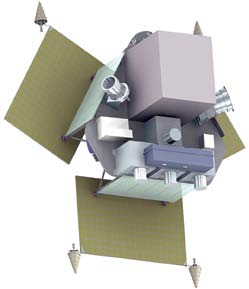
Artistic illustration of the MKA-PN 2 (Relek) satellite. Image is courtesy of Lomonosov Moscow State University.
The goal of the Relek payload is the detailed study of cosmic ray and magnetospheric energetic particles and their interactions with Earth’s upper atmosphere. Also, transient luminous events are studied by the satellite. The satellite will provide data for research into acceleration and precipitation of charged particles in Earth’s radiation belts, the interactions of high-energy particles with the ionosphere and atmosphere, and the connections of particle interactions with transient phenomena. To meet these objectives, the Relek payload will simultaneously observe electron and proton flux as well as electromagnetic waves and the low-frequency range which contribute to particle acceleration.
SkySat-2, the next smallsat iteration from SkyBox Imaging, will be primarily focused on Earth imaging and will offer resolutions of up to 3.3 feet (one meter). This smallsat is the second of the company’s planned constellation of 24 satellites.
TechDemoSat-1
TechDemoSat-1 (TDS-1), from Surrey Satellite Technology Limited (SSTL), is, basically, an on orbit test facility for a variety of payloads and software applications developed in the United Kingdom. There are eight payloads aboard TDS-1, which include a new form of battery charge regulator; new cell designs on two of the smallsat’s solar panels; a computer system that will enable the remote control of various software experiments; and a self-destruction technology that uses a sail to force the craft out of orbit to burn up in the Earth’s atmosphere.
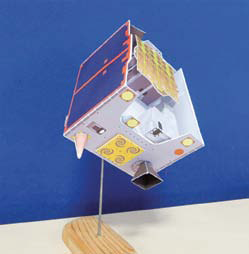
A scale model of TechDemoSat-1. Photo courtesy of SSTL.
UKube-1
Scotland’s first space satellite has been launched into orbit —UKube-1, designed and manufactured by Clyde Space in Glasgow, was one of the secondary payloads rocketed into space aboard the Russian Soyuz-2 launch vehicle.
There was a great deal of cheering at the Glasgow HQ of Clyde Space as the launch unfolded before them. The UKube-1 nanosatellite is about the size of a shoe box and is described by Clyde Space as being one of the most advanced of its kind, featuring GPS devices aimed at measuring plasmaspheric space weather, as well as a camera that will take images of the Earth and test the effects of radiation on space hardware. UKube-1 will orbit at 635 kilometers above Earth, and has an expected life span of five years, although its primary mission is expected to be completed within one year.”
Clyde Space chief executive Craig Clark said it is a very proud moment for the team. “I am delighted that the launch went so smoothly and the UKube-1 mission is underway. It is fantastic that a spacecraft designed, built and tested in Scotland by a Scottish company has been so successful and I’d like to thank everyone who backed us and contributed to this amazing project.”
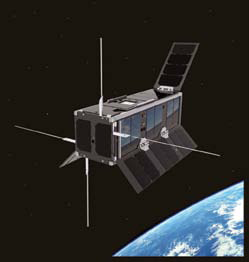
Andrew Strain, vice-president of engineering at Clyde Space, recently returned from Baikonur where he supervised the integration of UKube-1 on to the rocket. He said, “UKube-1 shipped out six months ago so our first task was to make sure everything was still healthy. The beauty of the CubeSat is that at the launch site we were able to set up the test kit and do all the checkouts within a few hours, confirming we were good to go. Once that was done all that remained was to bolt the satellite to the launcher and wait for the launch.”
Ukube-1, part of the UK’s national collaborative CubeSat program, will test several new technologies in space. The payloads flying on UKube-1 were selected following a competition administered by the UK Space Agency to find the most innovative and creative payloads in the UK for a CubeSat. The competition received more than 20 payload submissions, several of which are also being considered for future missions.
Payloads on UKube-1 include:
• TOPCAT, from the University of Bath, is the first GPS device aimed at measuring plasmaspheric space weather
• The CMOS Image Demonstrator by the Open University is a camera that will take images of the earth and test the effect of radiation on space hardware using a new generation of image sensor
• Astrium’s “Janus” Experiment to demonstrate the feasibility of using cosmic radiation to improve the security of communications satellites and to flight test lower cost electronic systems
• AMSAT’s FUNcube-2, an outreach payload allowing school children of primary and secondary age to interact with the spacecraft
Also onboard the Clyde Space satellite is an advanced On-Board Computer (OBC) from Steepest Ascent in Glasgow, Scotland, and an S-band Transmitter from Cape Peninsula University of Technology. UKube-1 is essentially a technology demonstration mission and most of the payloads on UKube-1 are already being used on other CubeSat missions around the world.
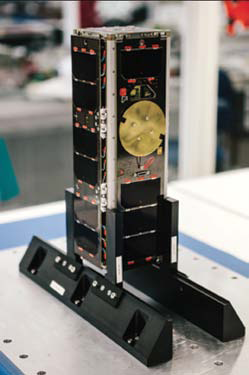
Clyde Space took on the role as “platform prime” for the build and development of UKube-1 and it was the company’s responsibility to deliver the complete mission for the UK Space Agency, from concept to delivery to the launch site. The majority of the design and system integration took place at the company’s high-tech facility in the West of Scotland Science Park. UKube-1 consists of a combination of standard off the shelf subsystems from Clyde Space’ CubeSat Lab, modifications to standard subsystems and new products. The company provided an interface emulator to all payload teams at the start of the program. This allowed the rapid parallel development of subsystems —payloads that could be developed and tested without the need to interface to the spacecraft platform. Both the payload and the platform could, therefore, be developed simultaneously. This will be beneficial for other missions in future and the product is currently for sale in the Clyde Space cubesat shop.
On-Board software was developed for UKube-1 in collaboration with Bright Ascension. The software was designed for the command and data handling needs of the next generation of highly capable cubesats and is also available to purchase for use on other spacecraft and can be easily supplemented with new components and payloads when necessary to suit various mission configurations.
The deployable solar panels have more features than ever before, as they were built to support the large amount of power required for a multi-payload mission, with the company able to improve and test a more integrated solar panel that would supply power and interface sensors and actuators to the ADCS. This included the use of sun detectors and sun sensors as well as embedded magnetorquers. Additionally, the solar panels accommodated S-band patch antenna and a GPS antenna.
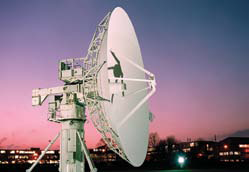
RAL Space is the primary operator for UKube and has established a UHF/VHF ground station, which commands the satellite A 2.4m S-band antenna will be used to provide data downlink for UKube. These two systems will be able to support amateur satellites within the international community.
Supporting the power delivery from the new deployable solar panels required an updated EPS. The design was extended to enable it to handle the increased power from the panels and to deliver more power to the payloads and subsystems. Modularity of the system was improved by increasing the number of arrays that can be interfaced. The isolation switch was re-configured to reduce the risk of high currents being carried in physical switches which has, in turn, reduced the magnetic impact of the system (e.g., the resultant magnetic force from currents running through harnessing). Also increased was the number of regulated power buses to accommodate the needs of all the payloads.
The S-Band transmitter used on UKube-1 offers the highest data rate for downlink of any others on the market at the moment and was developed in collaboration with CPUT and FSATI and is increasingly important as cubesats become more complex.
Craig Clark added, “UKube-1 has been years in the making, with a great deal of hard work from our fantastic Clyde Space team. As anyone in the business will tell you, there’s nothing easy about designing a spacecraft, especially one as complex as UKube-1, so the achievement is a testament to the capability and application of the team here. It has also been a dream for me, to be responsible for producing Scotland’s first satellite. I’m very proud of UKube-1. But we’re not stopping there. This is the first of many, and by that I mean hundreds of satellites of this size to be produced in Glasgow in the coming years.”
The Clyde Space infosite is located at http://www.clyde-space.com/

